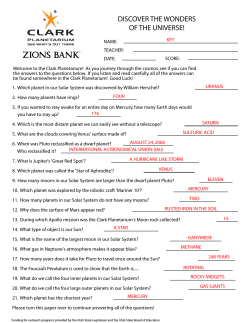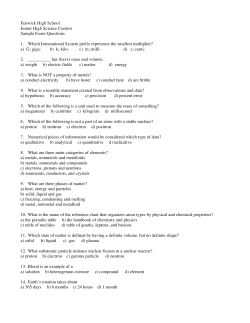
Mathematical Relationships of Solar System Bodies revealed using
Mathematical Relationships of Solar System Bodies revealed using the Single Body Breakup Hypothesis indicate radical rethinking required of early Earth models by T. Frank Lee, M.App.Sc., B.Sc., Dip.C.E., F.Aus.I.M.M. (www.franklee-geologist.com) The diagrams shown below give the sequence of formation of our Solar System. Only the larger bodies are considered; bodies smaller than Europa being excluded from the discussion. The steps of the sequence given by the diagrams displayed are laid out in the deductive style. However, the sequence was determined using the reverse of this – by induction – i.e., from present to past. The breakup of the impurely stratified, ellipsoidal “brown body” to form protoJupiter and Saturn (Steps 2 and 3) obeyed the Jacobi First Bifurcation Point (refined by Maclaurin and by Darwin) for a rotating, prolate, ellipsoidal mass of gas. Separation into two parts occurs when the ellipsoid a-axis is 1.5x (closely 1.232x) the radius of a sphere containing the same volume. Because the body was not a pure gas but had a highly density-stratified core, separation was not theoretically perfect and the interior stratified heavy matter of protoJupiter had to readjust to maintain ‘force after’ = ‘force before’ in the closedforce system. This caused collapse inwards of outer matter, resulting in a central impulsive force which ejected some of the internal matter. These two mechanisms alternated until all, or almost all, internally displaced matter was ejected (Steps 3 to 9). Note the frequency of the numbers 1.23, 1.19, and 0.724 ( = 0.9816, = 1.38-1). These numbers (1.36 and 1.37 in place of 1.38) occur as ratios throughout the Universe; from the spacing of galaxies down to the spacing of an atom’s electrons. 1.19 x 1.23 x 0.724-1 = 2.022 = 1.19244. (1.19 x 1.23 x 1.37 gives 2.) orbitS2 MJ ––– = ––––––– MS orbit J2 orbit = distance from Sun T. Frank Lee • © 2008 • www.franklee-geologist.com Poorly differentiated protoJupiter. Mercury / Venus / Earth = a, satellites = b + c, Neptune = d, Uranus = e, Jupiter = f Change in ratio of deuterium to hydrogen: Venus > Mars > Earth > Neptune > Uranus > Jupiter/Saturn Mercury / Venus / Earth (a) T. Frank Lee • © 2008 • www.franklee-geologist.com pdt = M.v / π.R2. v = orbit speed about Jupiter (For Mars, vMars – vpJ about Sun.) vpJ = 12.9km.sec-1 Recent study has shown the “silicate” string of bodies formed with the centre of the large composite body coincident with that of protoJupiter. T. Frank Lee • © 2008 • www.franklee-geologist.com At the start of final internal breakup – At the start of final internal breakup – the formation of the lesser planets. the formation of the lesser planets. (22.24˚) (22.24˚) (91.83˚) (91.83˚) T. Frank Lee • © 2008 • www.franklee-geologist.com SOME COMMENTS 1. A T-Tauri effect would have taken place between Steps 1 - 2. Thus it is to be expected that a (faint) disc of some sort would develop about the Sun. The T-Tauri mechanism together with centrifuge separation of matter within the molecular (?) cloud gives a simple explanation for the Solar System’s 18O being uniquely higher (+40%) than that of our galaxy. 2. As the “brown” body core passed out of the molecular (?) cloud (Step 1 - 2) there would have been a rapid increase in the cloud’s moment of inertia factor, leading to collapse of the cloud to form a Sun having angular momentum less than that of the total of its satellites (the planets). Thus the unexpected phenomenon for our Sun. 3. In step 9, at the start of the ejection Venus blocked the faster-moving Mercury, stopping Mercury’s rotation and slowing that of Venus. Mercury rolled around Venus and so acquired a rotation related to that of Venus and a virtually vertical axial tilt. Using the orbit speed formula given below (see 6), the measured v’s of Venus and Mercury, and the mechanism described above permits a formula to be developed to calculate the rotation of Neptune. 4. Ejection of each of the planet and satellite groups of bodies would have been accompanied by a “rain” of “spatter”, comparable to a volcano. This “spatter” would be the meteors and comets of the Solar System. Their compositions should thus be dominantly those of the larger bodies. A brief study of these bodies, including their isotopes’ variations, suggest this is so. 5. The orbit distance of protoJupiter from the Sun was determined using the formula ∑(m/d2) = ∑(m)/D2, where m = mass of each Solar System body and d its orbit distance from the Sun. The value of D is 5.3 AU. Orbit speed is 12.9 km.sec-1. The impulse ejection mechanism for the lesser planets and satellites as given in the diagrams must obey Newton’s Third Law, i.e., mN/(dN – 5.3)2 + mU/(dU – 5.3)2 must closely equal mMy/(5.3 – dMy)2 + mV/(5.3 – dV)2 + mE+Mn/(5.3 – dE)2 + mMs/(5.3 – dMs)2. (Pluto and Ceres have been ignored.) Calculation shows such to be the case. 6. Force being related to angular momentum, it follows that the orbit speeds of the planets about the protoJupiter position should be related to the speed of protoJupiter. And they are. The orbit speeds (v) of the planets obey the formula v = 12.9 x 1.23n for n = +6 (Mercury), +5, +4, +3, +2 (edge Asteroid belt), +11/2 (Ceres), +1 (edge Asteroid belt), 0, - , -11/2 (Saturn), -2 (Chiron), -3, -4, -5 (Pluto), -6 (edge of Kuiper Belt?) T. Frank Lee • © 2008 • www.franklee-geologist.com 7. As the present-day axial tilt ratios of the planet couples Jupiter/Saturn, Uranus/Earth, Neptune/Venus, (Mars/Moon, Triton/Pluto) are the same as they have been calculated to have been at separation (Saturn) and ejection, it follows the axial tilts of the planets are primary features. There can have been NO tilting by giant impacts or by collision/reconstitution of bodies. Small impacts possibly caused minor wobble. inclined from the geometric figure axis. Past workers have suggested this for Mars and Moon. It is therefore no surprise that the dipole axial tilts of the following planets are offset, obeying the ubiquitous formula A = B x Cn. In this case, t = 9.6 x 1.22n, where n = 0 (Jupiter), 1 (Earth), 2 (Mars), 8 (Neptune), and 9 (Uranus). This conclusion is of great importance when studying the Earth. See note E in the Geological Implications section below. 8. Saturn did not suffer ejection. All partly-differentiated bodies which did, as described above (less Mercury and Venus?), must almost certainly have had their cores offset to some extent. That is, the bodies should exhibit asymmetric structure; the inner core axis of each should be offset and 9. The product of the orbit times of the planets, plus Ceres and Pluto, about the Sun in Earth years multiplied by 3 = 3x0.241x0.615x1x1.881x4.60x11.86x29.46x84.0x164.8x247.7 = 4.60935 x 109 years – the Age of the Solar System. SOME GEOLOGICAL IMPLICATIONS A The radial relationships of Earth to the other “silicate” bodies (excluding Mercury), to that of Uranus ( = that of Venus to Neptune), and to planetary axial tilts, plus other evidence, show that the Earth has suffered NO expansion of any but a trifling amount over its whole life. The same can be said for its mass. B The rotation ratios of the planet couples Jupiter/Saturn, Uranus/Earth, and Neptune/(Venus + Mercury) are the same in the Present as what they were at their origins. It follows that the rotation of Earth, on average, has remained the same over its whole life. But it is known the Moon is slowing Earth’s rotation. Therefore there must be a mechanism which periodically speeds up the Earth. One can be suggested. (See web site.) C Because of Comment 7, i.e., Earth’s tilt has remained constant over the body’s whole life (excluding some minor wobble due to impacts), the current suggestion that Proterozoic glaciation was due to a large-angle change of tilt is invalid. D Development of the Solar System as shown by the diagrams leads to the conclusion that the inner core of the Earth is not dominantly Ni/Fe but a mixture of metastable, high pressure minerals. Analyses of meteorites can be argued as supporting this view. E If Earth has an offset core (suggested in Comment 8) and the core is a metastable, solid body surrounded by a fluid medium then the known difference in behaviour of deep Earth seismic waves in its “eastern” and “western” hemispheres is explained. It also explains the differences between theoretical and actual values in other seismic studies that have appeared in print over the years. T. Frank Lee • © 2008 • www.franklee-geologist.com The location and orientation of the inner core was determined in 1987 during a geological study of the Earth’s surface structures. The inner core centre was computed to be at the intersection of a straight line drawn between the two magnetic poles and the 6° N latitudinal plane. The offset is towards the Pacific Ocean. (See MAppSc thesis RMIT University, 1989 and web site.) the continental plates of matter (Sial) were in existence from the beginning of Earth. They did not form by exudation, and/or differentiation during Primordial time. There is evidence for this. It can be said, then, that hypotheses of Primordial Earth based on the Nebula Theory must be false. This, in turn, casts doubt on likewise based models of Early Archaean and the development of life on Earth. F A core as described in E can produce a magnetic field, the strength of which will vary over geological time and suffer intermittent reversals. The main field (there should be and are two) will be offset and inclined to the figure axis. I Using published paleomagnetic poles for a single continental plate and the method of Plate Path Plotting, which is based on the concept of an offset core See “Gondwana Eight” pp.523-9: Balkema Press, Rotterdam, 1993 or references above) the plate can be moved step-by-step back in time from the present to give latitude, longitude, and orientation at each step. Plotting has been done for all continents back to the Cambrian. Looked at from past to present the plates appear to slide over the curved Earth (Sima), at each step paralleling one of the vertical principal or stress planes mentioned in Implication G. The plates kept remarkably constant form and ricocheted from one another or became attached or broke off when they met. An example of the plotting is attached. G The offset and description of the Earth’s inner core given above allows a triaxial stress figure to be constructed for the inner Earth, giving the locations of principal axes, principal and shear planes, and what I term “cones of stress” planes about the two “horizontal” stress axes. These coincide with megastructures on the Earth’s surface. (See web site.) H The sum of the areas of Earth’s continental plates equals the surface area of Mars. This is almost certainly because Mars had to separate from the differentiated “silicate” core at a mathematically determined size, leaving a skin of Mars-type silicate on the core that became part of the following Earth. Thus The above work is part of a study of the Earth and the Solar System carried out over 20 years. by T. Frank Lee, M.App.Sc., B.Sc., Dip.C.E., F.Aus.I.M.M. (www.franklee-geologist.com)
© Copyright 2025













